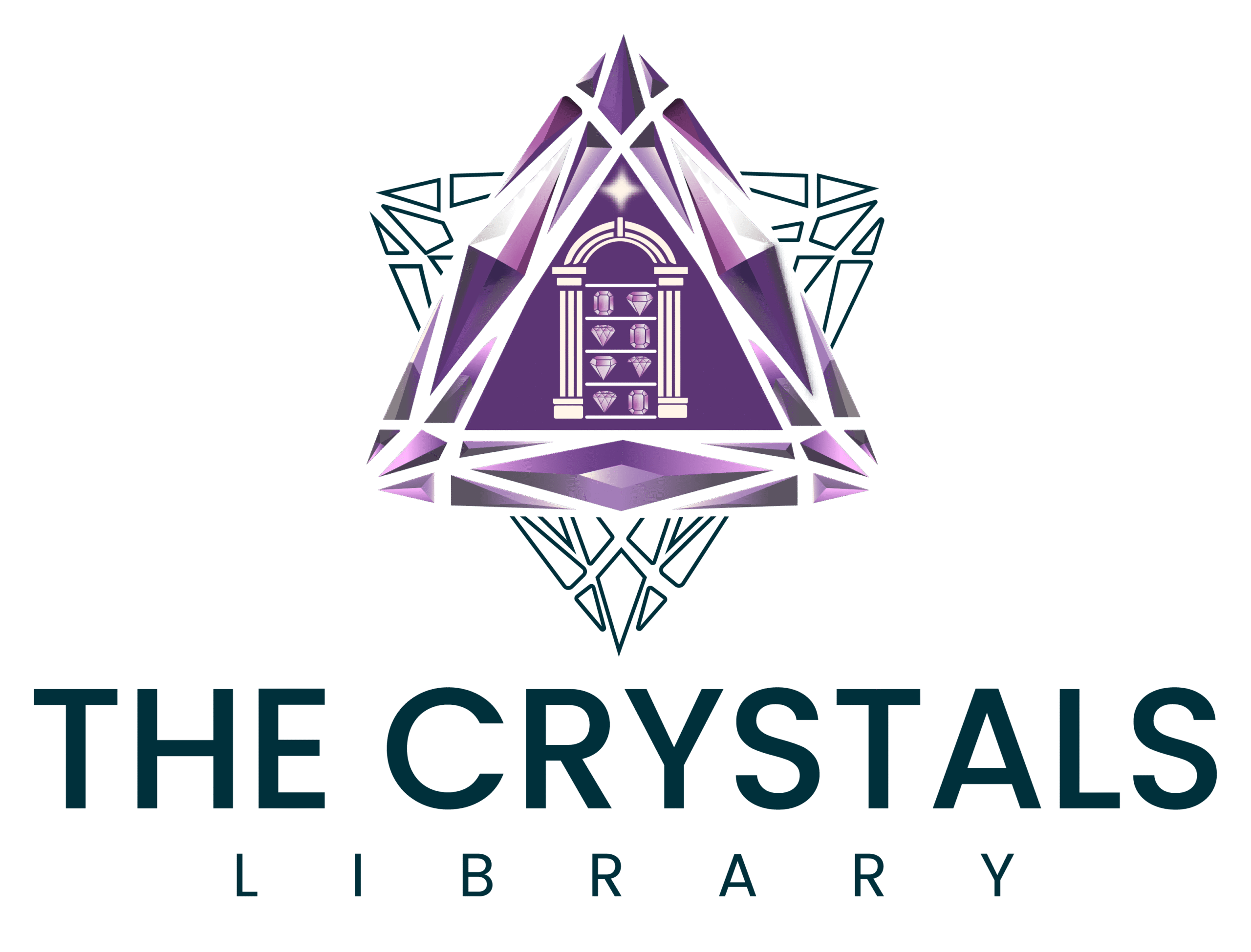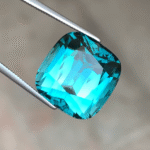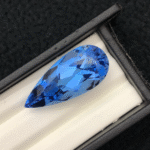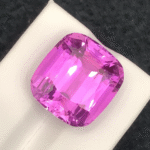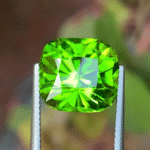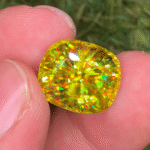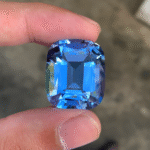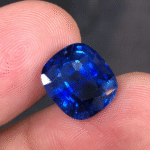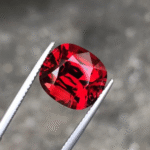What is Celestine? A Brief Guide to This Rare Mineral

By The Crystals Library Team – Your trusted source for authentic crystal knowledge and spiritual guidance
Walking along a quiet shoreline with the sun warming your face, you might spot a hidden treasure glistening among the rocks—a piece of Celestine. This remarkable mineral, also called celestite, feels like holding a fragment of the sky in your hands. Found in the Earth’s crust, it is made of strontium sulfate (SrSO4) and often occurs in sedimentary rocks as colorless, pale blue crystals, or in delicate masses. From white and pink tones to rare orange found in Ontario, Canada, its range is breathtaking. Some of the most striking specimens come from Madagascar, Sicily, and Italy, where collectors prize it as a decorative or ornamental stone. The name comes from the Latin word Caelestis, meaning celestial or heavenly, perfectly mirroring its natural beauty.
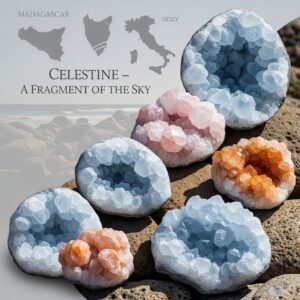
As someone who has studied mineralogy, I’ve seen Celestite and Coelestine specimens that seem almost alive with divine power, enhancing understanding, higher consciousness, and mindfulness during meditation and prayer. Whether nestled in geodes, woven as fibers in river, streams, ocean beds, or lying alongside Gypsum, Anhydrite, and Halite, its presence is unmistakable. Variants like pale green, brown, and black are just as captivating, while rare historical names such as Eschwegite, Lévy, and Sicilianite remind us of its rich heritage. I’ve even held pieces from quiet lakes that spark curiosity not only for their chemistry but for the stories they seem to carry from worldwide corners.
History of Celestine
The story of Celestine spans centuries, tracing back to ancient civilizations who looked to the night sky and the stars in awe, never knowing such celestial beauty lay hidden among the Earth’s treasures still undiscovered. When the soft blue hues of its crystals were finally recognized, this heavenly mineral began to captivate scientists, scholars, and collectors alike. Its unique properties and mysterious secrets soon earned it a place in history as a prized possession, admired for its versatility whether displayed on shelves or kept safely in a cabinet. For me, examining it under a light feels like holding a fragment of the world’s natural wonders—a blend of divine connotations and geological intrigue that continues to inspire enthusiasts and fuel scientific discovery.
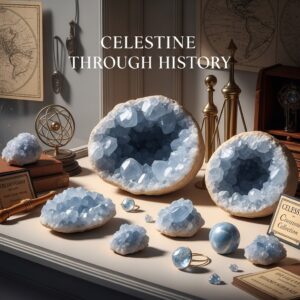
In the scientific community, Celestite holds a special place not only for its beauty but for its composition rich in elements like strontium. Even tiny Protozoa creatures called Acantharea built their skeletons by biomineralizing this mineral, creating a crystal-fibrous structure that gave each cell a star-like appearance. These would fossilize less and instead crystalize into remarkable cultures, a phenomenon noted in the description of the element in 1792 and the naming of Celestite in 1798. As a source for metal salt used in red-colored fireworks, it surprises many that it doesn’t produce blue flames—those come from copper, known for its orange-red burn. Due to its fragility, cutting and facet work is challenging, and most stones remain under ten carats, often appearing in raw, uncut, or geode displays of various sizes, or crafted into delicate jewelry pieces.
Physical Properties of Celestine
Celestine is admired for its calming energy and connection to higher awareness, offering both visual beauty and a soothing presence in spaces. It is believed to promote inner peace and clarity of thought.
The beauty of Celestine lies in its enchanting color—from soft pale blue tones of a clear summer sky to deeper ocean-inspired hues that feel both serene and soothing. As a mineral, it often reveals a striking crystal structure with slender, elongated, prismatic shape, and smooth, glassy surfaces. These range in size from tiny specks to grand formations of dazzling brilliance. Its perfect cleavage allows it to break along planes, much like slicing a loaf of bread into neat slices, producing flat surfaces that reflect and refract light into captivating patterns. I’ve often admired how its features, from tiny pockets of air to hidden crystalline cavities called vugs, sometimes host other minerals or gas bubbles, making each piece a truly unique art form crafted by the Earth itself.
-
Found in occurrences and deposits worldwide, from Afghanistan to every corner of the globe
-
Valued as a collector’s item, a prized possession among collectors and enthusiasts
-
Displayed in cabinets for its shimmering, intricate, and vibrant colors
-
Offers versatility beyond its decorative roles, inspiring research into future uses and applications
-
Researchers see potential for energy storage, such as batteries for smartphones and electric vehicles, potentially revolutionizing tech
-
Technological advancements in nanotechnology aim to manipulate and enhance its properties for strength in construction, aerospace, and healthcare
-
Scientists explore its atomic-level composition and behavior to deepen understanding in materials science
-
Holds divine and celestial significance, linked to energy, cosmic and supernatural forces
| Property | Description |
|---|---|
| Color | Sky-blue to azure (most prized), colorless, white, reddish, greenish, brownish, or greyish |
| Hardness | 3 to 3.5 on the Mohs hardness scale |
| Luster | Vitreous (glassy), sometimes pearly on cleavage surfaces |
| Transparency | Transparent to translucent |
| Cleavage | Perfect {001}, Good {210} |
| Specific Gravity | 3.95 to 3.98 |
| Crystal System | Orthorhombic |
| Chemical Formula | SrSO₄ (Strontium Sulfate) |
Formation and Geological Occurrence
Celestine primarily forms in sedimentary rocks, particularly in environments where there is an abundance of strontium and sulfate ions. According to geological surveys, these conditions are often found in :
- Evaporite deposits: As water evaporates from ancient seas or lakes, dissolved minerals, including strontium sulfate, precipitate out, forming layers of Celestine. It is frequently associated with gypsum, halite, and anhydrite.
- Limestones and Dolostones: Celestine can occur as nodules, concretions, or disseminated crystals within these carbonate rocks.
- Cavities and Geodes: Some of the most spectacular Celestine specimens are found lining the inside of geodes, where the mineral has crystallized in open spaces within rocks. The famous Celestine geodes from Put-in-Bay, Ohio, are prime examples of this formation.
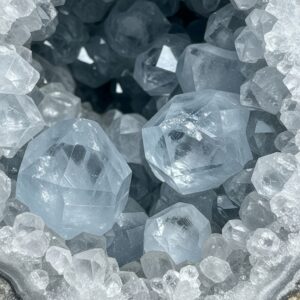
Geologically, Celestine’s presence often indicates specific past environmental conditions, particularly those involving the interaction of strontium-rich fluids with sulfate-bearing solutions. It is the most common strontium mineral and serves as the primary ore for strontium, which has various industrial applications including fireworks, electronics, and specialized glass manufacturing.
Chakra Associations
Celestine is particularly associated with the higher chakras, serving as a powerful activator and cleanser for these energy centers:
| Chakra | Location | Associated Benefits |
|---|---|---|
| Throat Chakra (Vishuddha) | Throat | Clear communication, self-expression, authentic voice |
| Third Eye Chakra (Ajna) | Between eyebrows | Enhanced intuition, spiritual insight, inner wisdom |
| Crown Chakra (Sahasrara) | Top of head | Divine connection, spiritual enlightenment, universal unity |
By working with these chakras, Celestine helps to create a harmonious flow of energy throughout the body, promoting overall well-being and spiritual alignment.
Healing Benefits of Celestine
Beyond its spiritual associations, Celestine is also cherished for its perceived healing properties, addressing both emotional and physical imbalances:
- Emotional Balance and Stress Relief: Its primary gift is its ability to bring profound calm. Celestine is widely used to alleviate stress, anxiety, and tension. It promotes emotional balance, helping to soothe an overactive mind and bring a sense of tranquility during challenging times.
- Communication and Expression: As a Throat Chakra stone, it supports clear and effective communication. It can be beneficial for public speakers, teachers, or anyone who needs to express themselves with confidence and clarity.
- Dream Work and Astral Travel: Many crystal enthusiasts use Celestine to enhance dream recall, promote lucid dreaming, and facilitate out-of-body experiences or astral travel.
- Physical Ailments (Supportive): While not a substitute for medical treatment, Celestine is often used as a supportive stone for various physical discomforts. It is believed to help with issues related to the throat, eyes, and ears.
How to Use Celestine for Personal Growth
Incorporating Celestine into your daily life can bring about noticeable shifts in your energy and outlook:
- Meditation: Place a piece of Celestine on your Third Eye or near your meditation space to deepen your practice
- Bedroom Placement: Keep Celestine in your bedroom to create a serene atmosphere and encourage restful sleep
- Work/Study Space: Place it on your desk to reduce stress and improve focus
- Crystal Elixir: Create a crystal elixir using the indirect method (due to its softness) to infuse water with its calming energy
- Jewelry: While soft, Celestine can be worn as jewelry to keep its soothing energy close throughout the day

About The Crystals Library
At The Crystals Library, we are dedicated to providing accurate, well-researched information about crystals and minerals. Our team combines scientific knowledge with respect for traditional crystal healing practices, ensuring our readers receive comprehensive and trustworthy guidance. We believe in the power of crystals to enhance well-being while maintaining transparency about the nature of metaphysical claims.
Conclusion
Celestine, whether you call it by its scientific designation or its more common name, Celestite, is truly a mineral of profound beauty and gentle power. From its fascinating geological origins as a strontium sulfate crystal to its revered status as a stone of peace, serenity, and divine connection, Celestine offers a unique blend of scientific wonder and spiritual solace.
Its sky-blue hues invite us to look inward, to find our own calm center, and to open our hearts to clear communication and spiritual wisdom. As we navigate the complexities of modern life, the growing appreciation for Celestine is a testament to our innate human need for harmony, balance, and a deeper connection to the unseen realms. By embracing this gentle giant of the mineral kingdom, we invite its soothing energy into our lives, fostering inner peace, emotional well-being, and a profound sense of spiritual upliftment.
Whether you’re drawn to Celestine for its scientific fascination, its spiritual properties, or simply its breathtaking beauty, this remarkable mineral offers something profound for everyone. Let Celestine be your guide to a more serene and connected existence.
